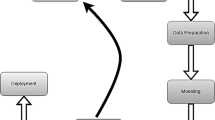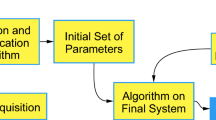Abstract
Visual quality inspection for defect detection is one of the main processes in modern industrial production facilities. In the last decades, artificial intelligence solutions took the place of classic computer vision techniques in the production lines and specifically in tasks that, for their complexity, were usually demanded to human workers yet obtaining similar or greater performance of their counterparts. This work exploits a Deep Neural Network for a smart monitoring system capable of performing accurate quality checks to detect welding defects in fuel injectors during the production stage. The contribution focuses on a novel approach to cope with unforeseen changes in production quality introduced by the alteration of a particular machine or process. Results suggest that pre-filtering could avoid the retraining of custom-designed networks. Moreover, the introduction of a weighting strategy on the confusion matrix allows obtaining good performance estimations even in the case of small and unbalanced datasets. Concerning a specific demanding case of an imbalanced dataset with very few positive examples, the system displayed a 96.30% accuracy on defect classification.






Similar content being viewed by others
References
Ak R., Ferguson M., Lee Y.T.T., Law K.H. (2017) Automatic localization of casting defects with convolutional neural networks. https://www.nist.gov/publications/automatic-localization-casting-defects-convolutional-neural-networks
Bell S., Upchurch P., Snavely N., Bala K. (2015) Material recognition in the wild with the materials in context database Computer Vision and Pattern Recognition (CVPR)
D’Avella S., Tripicchio P., Avizzano C. A. (2020) A study on picking objects in cluttered environments: exploiting depth features for a custom low-cost universal jamming gripper. Robot Comput Integr Manuf 63(101):888. https://doi.org/10.1016/j.rcim.2019.101888
Fang Z., Xu D., Tan M. (2011) A vision-based self-tuning fuzzy controller for fillet weld seam tracking. IEEE/ASME Transactions on Mechatronics 16(3):540–550. https://doi.org/10.1109/TMECH.2010.2045766
Gao Y., Gao L., Li X., Yan X. (2020) A semi-supervised convolutional neural network-based method for steel surface defect recognition, vol 61. http://www.sciencedirect.com/science/article/pii/S0736584518304770
He K., Zhang X., Ren S., Sun J. (2015) Deep residual learning for image recognition. arXiv:1512.03385
He K., Zhang X., Ren S., Sun J. (2016) Deep residual learning for image recognition. In: Proceedings of the IEEE Conference on Computer Vision and Pattern Recognition, pp. 770–778
Huang G., Liu Z., Van der Maaten L., Weinberger K.Q. (2016) Densely connected convolutional networks. arXiv:1608.06993
Huang G., Liu Z., Van Der Maaten L., Weinberger K. Q. (2017) Densely connected convolutional networks. In: Proceedings of the IEEE Conference on Computer Vision and Pattern Recognition, pp. 4700–4708
Krizhevsky A., Sutskever I., Hinton G.E. (2012) Imagenet classification with deep convolutional neural networks. In: Proceedings of the 25th International Conference on Neural Information Processing Systems - Volume 1, NIPS’12, pp. 1097–1105. Curran Associates Inc., USA. http://dl.acm.org/citation.cfm?id=2999134.2999257
Larsson G., Maire M., Shakhnarovich G. (2016) Fractalnet: ultra-deep neural networks without residuals. arXiv:1605.07648
Lin T. Y., Goyal P., Girshick R., He K., Dollár P. (2017) Focal loss for dense object detection. In: Proceedings of the IEEE International Conference on Computer Vision, pp. 2980– 2988
Malamas E.N., Petrakis E.G., Zervakis M., Petit L., Legat J.D. (2003) A survey on industrial vision systems, applications and tools. Image and Vision Computing 21(2):171–188. https://doi.org/10.1016/S0262-8856(02)00152-X. https://www.sciencedirect.com/science/article/pii/S026288560200152X
Masci J., Meier U., Ciresan D., Schmidhuber J., Fricout G. (2012) Steel defect classification with Max-Pooling Convolutional Neural Networks. In: 2012 Int. Jt. Conf. Neural Networks, pp. 1–6. IEEE. http://ieeexplore.ieee.org/document/6252468/, https://doi.org/10.1109/IJCNN.2012.6252468, (to appear in print)
Mower J. P. (2005) Prep-mt: predictive rna editor for plant mitochondrial genes. BMC bioinformatics 6(1):96
Pandiyan V., Murugan P., Tjahjowidodo T., Caesarendra W., Manyar O.M., Then D.J.H. (2019) In-process virtual verification of weld seam removal in robotic abrasive belt grinding process using deep learning. Robotics and Computer-Integrated Manufacturing 57:477–487. https://doi.org/10.1016/j.rcim.2019.01.006. http://www.sciencedirect.com/science/article/pii/S073658451830406X
Podržaj P., Čebular A. (2016) The application of lvq neural network for weld strength evaluation of rf-welded plastic materials. IEEE/ASME Transactions on Mechatronics 21(2):1063–1071. https://doi.org/10.1109/TMECH.2015.2498278
Ren R., Hung T., Tan K. C. (2018) A generic deep-learning-based approach for automated surface inspection. IEEE Transactions on Cybernetics 48(3):929–940. https://doi.org/10.1109/TCYB.2017.2668395
Rout A., Deepak B., Biswal B. (2019) Advances in weld seam tracking techniques for robotic welding: a review. Robotics and Computer-Integrated Manufacturing 56:12–37. https://doi.org/10.1016/j.rcim.2018.08.003. http://www.sciencedirect.com/science/article/pii/S0736584517302132
Russakovsky O., Deng J., Su H., Krause J., Satheesh S., Ma S., Huang Z., Karpathy A., Khosla A., Bernstein M., Berg A.C., Fei-fei L. (2015) Imagenet large scale visual recognition challenge. International Journal of Computer Vision (IJCV) 115(3):211–252. https://doi.org/10.1007/s11263-015-0816-y
Sassi P., Tripicchio P., Avizzano C. A. (2019) A smart monitoring system for automatic welding defect detection IEEE Transactions on Industrial Electronics
Senthil Kumar G., Natarajan U., Ananthan S.S. (2012) Vision inspection system for the identification and classification of defects in MIG welding joints. Int. J. Adv. Manuf. Technol. 61(9-12):923–933. https://doi.org/10.1007/s00170-011-3770-z. http://link.springer.com/10.1007/s00170-011-3770-z
Shah H.N.M., Sulaiman M., Shukor A.Z., Kamis Z., Rahman A.A. (2018) Butt welding joints recognition and location identification by using local thresholding. Robotics and Computer-Integrated Manufacturing 51:181–188. https://doi.org/10.1016/j.rcim.2017.12.007. http://www.sciencedirect.com/science/article/pii/S0736584517301825
Shao J., Yan Y. (2005) Review of techniques for on-line monitoring and inspection of laser welding. Journal of Physics: Conference Series 15(1):101–107. https://doi.org/10.1088/1742-6596/15/1/017. http://stacks.iop.org/1742-6596/15/i=1/a=017?key=crossref.db19901016cb0ead0470f822ed8309c4
Srivastava R.K., Greff K., Schmidhuber J. (2015) Highway networks. arXiv:1505.00387
Xie S., Tu Z. (2015) Holistically-nested edge detection. In: Proceedings of the IEEE International Conference on Computer Vision, pp. 1395–1403
Xiong J., Liu G., Pi Y. (2019) Increasing stability in robotic gta-based additive manufacturing through optical measurement and feedback control. Robotics and Computer-Integrated Manufacturing 59:385–393. https://doi.org/10.1016/j.rcim.2019.05.012. http://www.sciencedirect.com/science/article/pii/S073658451830231X
Yan Z., Zhang G., Wun L. (2011) Simulation and controlling for weld shape process in p-gmaw based on fuzzy logic. In: 2011 IEEE International Conference on Mechatronics and Automation, pp. 2078–2082. https://doi.org/10.1109/ICMA.2011.5986301
Yosinski J., Clune J., Bengio Y., Lipson H. (2014) How transferable are features in deep neural networks. arXiv:1411.1792
Zahran O., Kasban H., El-Kordy M., El-Samie F.A. (2013) Automatic weld defect identification from radiographic images. NDT E Int 57:26–35. https://doi.org/10.1016/J.NDTEINT.2012.11.005. https://www.sciencedirect.com/science/article/pii/S0963869512001557
Zammar I. A., Mantegh I., Huq M. S., Yousefpour A., Ahmadi M. (2015) Intelligent thermal control of resistance welding of fiberglass laminates for automated manufacturing. IEEE/ASME Transactions on Mechatronics 20(3):1069–1078. https://doi.org/10.1109/TMECH.2014.2366100
Zhao J., Sheng H., Zhou X. (2016) Study on the application of acoustic emission testing technique in monitoring 16mn steel welding defects. In: 2016 International Conference on Advanced Mechatronic Systems (ICAMechs), pp. 318–321, https://doi.org/10.1109/ICAMechS.2016.7813467, (to appear in print)
Zheng K., Li J., Lei Tu C., Song Wang X. (2016) Two opposite sides synchronous tracking x-ray based robotic system for welding inspection. In: 2016 23rd International Conference on Mechatronics and Machine Vision in Practice (M2VIP), pp. 1–5, https://doi.org/10.1109/M2VIP.2016.7827334, (to appear in print)
Zhou S., Chen Y., Zhang D., Xie J., Zhou Y. (2017) Classification of surface defects on steel sheet using convolutional neural networks. Mater. Tehnol. 51:123–131
Author information
Authors and Affiliations
Corresponding author
Additional information
Publisher’s note
Springer Nature remains neutral with regard to jurisdictional claims in published maps and institutional affiliations.
Rights and permissions
About this article
Cite this article
Tripicchio, P., Camacho-Gonzalez, G. & D’Avella, S. Welding defect detection: coping with artifacts in the production line. Int J Adv Manuf Technol 111, 1659–1669 (2020). https://doi.org/10.1007/s00170-020-06146-4
Received:
Accepted:
Published:
Issue Date:
DOI: https://doi.org/10.1007/s00170-020-06146-4




